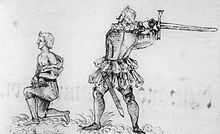Franz Schmidt (executioner)

Franz Schmidt (1555 – 1634), also known as Meister Franz, was executioner in the region of Bamberg from 1573 to April 1578, and from 1 May 1578 till the end of 1617 executioner of Nuremberg. He left a diary in which he detailed the 361 executions he performed during his 45 years in office.[1]
Personal and professional life
Franz Schmidt's father, Heinrich, was originally a woodsman in the north-eastern Bavarian town Hof. Once, when the notoriously tyrannical margrave of Brandenburg-Kulmbach, Albrecht II (r. 1527–1553), wanted three men hanged, he picked out Heinrich from the crowd and forced him to perform the execution, after which he had no option but to continue in the profession of executioner. [2]
Franz Schmidt probably born in 1555, and was about 18 years old when he became executioner under his father's supervision in Bamberg in 1573. Five years later, in 1578, he secured the post as executioner in Nuremberg. He married the chief executioner's daughter Maria, and eventually became chief executioner after his father-in-law. He fathered seven children, and his salary, on par with the city's wealthiest jurists, allowed him to have a spacious residence in Nuremberg. After his retirement in 1617, he began a new, lucrative career as medical consultant. He was given a state funeral in 1634, in Nuremberg's most prominent cemetery, just a few paces away from the graves of famous individuals like Albrecht Dürer and Hans Sachs[1]
Throughout his career as an executioner, Franz Schmidt also had a side job as a healer; according to Joel Harrington, Schmidt's own estimate of patients seeking medical advice amounted to some 15.000 consultations.[3]
Social position of an executioner
The societal position of the professional executioner was ambiguous, as Harrington explains[1]
Legally empowered to torture, maim, and kill suspected or convicted criminals, the professional executioner is one of the more evocative and charged symbols of pre-modern Europe’s otherness. A ubiquitous and integral part of the European social fabric well into the modern era, these human “weapons of justice” were simultaneously viewed with suspicion and disdain by the very communities they served, formally marginalized as members of the “dishonourable trades”, a delimited menagerie that included slaughterhouse workers and gravediggers. And yet “Meister Frantz”, as he was popularly, endearingly known, remained a revered member of the local establishment, widely respected for his piety and steadfastness.
Furthermore,[1]
Schmidt’s life, in virtually every respect, had been a great social success, although the dishonourable nature of his profession consistently precluded his open participation in patrician and craftsmen circles alike, placing him and his family in a unique kind of social limbo.
Significance of diary
His journal of punishments executed by him has survived and contains 361 executions and 345 minor punishments (floggings and ear or finger amputations). The individual entries contain date, place, and method of execution, name, origin, and station in life of the condemned and – in later years more verbose than in the earlier ones – details of the crimes on which the sentence was based.
Schmidt executed criminals by rope, sword, breaking wheel, burning, and drowning. The wheel was reserved for severely violent criminals, burnings (for homosexual intercourse and counterfeiting money) occurred only twice in his whole career, and drowning – prescribed by the Carolina for a woman committing infanticide – was commuted regularly in the Nuremberg of Schmidt’s time into execution by sword, partly upon the intervention of Schmidt and some clergy.
Schmidt’s journal is unique as a source of social history and history of law. The autograph is no longer extant, but – according to the preface of a modern edition – libraries at Nuremberg and Bamberg owned, as late as 1913, four handwritten copies made between the 17th and the start of the 19th century. The first printed edition appeared in 1801.
See also
- Peter Niers, German serial killer executed (not by Schmidt) in 1581 for 544 murders
References
- Notes
- ↑ 1.0 1.1 1.2 1.3 God's Executioner
- ↑ in the retelling of Joel F. Harrington: "They didn't have a standing executioner and the prince, in a crowd, said to Heinrich Schmidt, Frantz's father: You! You are going to hang these guys! Heinrich replied, I'm not going to do that. The prince said: You hang them or I am going to string you up instead, as well as the two men standing next to you. So Heinrich did it. And once he did it there was no other job. Nobody wanted to have anything to do with him. He and his children were condemned to the occupation." The Faithful Executioner: Joel F. Harrington on the life of sixteenth-century executioner Frantz Schmidt.
- ↑ June 5th 2013: 1573: Meister Frantz Schmidt’s first execution
- Sources
- God's Executioner, essay in December 21, 2009 Berlin Review of Books, by Joel Harrington, professor at Vanderbilt University, author of The Unwanted Child: The Fate of Foundlings, Orphans, and Juvenile Criminals in Early Modern Germany The University of Chicago Press, 2009.
- A Hangman’s Diary: Being the Authentic Journal of Master Franz Schmidt, Public Executioner of Nuremberg 1573–1617. Translated by C. Calvert and A.W. Gruner. Edited, with an Introduction, by Albrecht Keller. Published by D. Appleton, second impression October, 1928.
- Meister Frantzen Nachrichter alhier in Nürnberg all sein Richten am Leben, published by J.M.F.v.Endter, Nürnberg, 1801
- Zasky, Joel; Failure Magazine: The Faithful Executioner Joel F. Harrington on the life of sixteenth-century executioner Frantz Schmidt.
- Executedtoday.com: June 5th: 1573: Meister Frantz Schmidt’s first execution, interview with Joel f. Harrington
- WYPL Book Talk, May 11th 2013: Podcast - Joel Harrington, 40-minutes interview by Steven Usery with Joel F. Harrington on Frantz Schmidt
- Harringto, Joel F. Excerpt from The Faithful Executioner at May 30th 2013 Slate Magazine: The Director of the Theater of Horror
External links
|